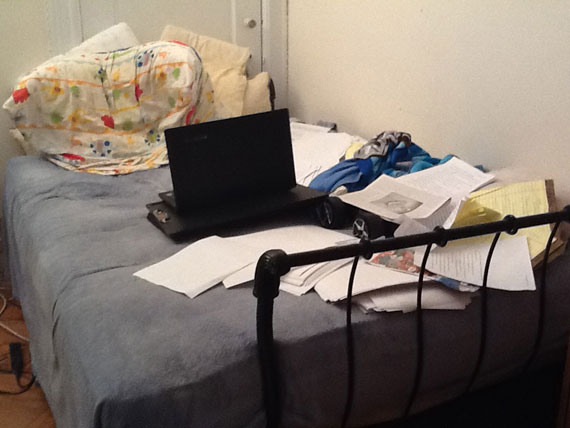So that you may get to know us better, it’s The Millions Quiz, yet another occasionally appearing series. Here, as conceived of by our contributor Emily, we answer questions about our reading habits and interests, the small details of life that like-minded folks may find illuminating, and we ask you to join us by providing your own answers in the comments or on your own blogs.
Today’s Question: This one is inspired by a recent item at The Morning News. With print subscriptions becoming increasingly rare for many people, what magazines or newspapers do you still subscribe to in print and why?
Garth: I’ve already given this question a fair amount of thought, insofar as my life is an attempt to ride herd over the thousands of pages of print that make their way into my apartment. Over the years, I’ve subscribed to The Believer, The Atlantic, A Public Space, and, during the Lewis Lapham era, Harper’s. (I’ve got my eye on Lapham’s Quarterly, the strikingly dense and beautiful journal the former Harper’s editor now helms.)
Through trial and error, I’ve found I can handle about three subscriptions at any given time before the coffee-table magazine offerings start to take a serious toll on my ability to get anything done. The New York Review of Books feels like a keeper, and I need to renew with n+1. But the one I can’t live without is (of course) The New Yorker. John Updike celebrated the magazine as “a heedless river of print” flowing from Manhattan to Shillington, Pennsylvania. For me it’s more like a family. There are favorite aunts, cousins I wish I saw more often, uncles I dread having to talk to. Some encounters are transcendent and some forgettable. Still, I’d never choose not to have a family, and, barring financial disaster, I’d never choose not to receive the print edition of The New Yorker.
Ben: Comic books remain the only “magazines” that absolutely must be consumed in their original form. They gain nothing from being digitized. Not only do you lose all of the tactile enjoyment of handling them, the pleasure of going to the store and gabbing with the other comic book nerds, and the vain hope that they might one day pay for your retirement, but they’re actually much more difficult to read online. I tried following Spiderman on the Marvel site for a while, but the computer’s aspect ratio means that either you have to do a lot of scrolling (incredibly irritating) or the artist’s vision becomes compromised. Although it’s certainly possible to make comics work online, in doing so, you create a different art form, something that’s no longer a comic book, but some strange cross between animation and a comic strip. Thanks, but no thanks.
Andrew: As a Globe and Mail copy editor, I have easy online access to the paper whenever I want, at my desk, while working, and no one will bat an eye. On Saturdays, however, I like to have my own copy of the weekend Globe. I’ll physically buy it from the newsstand and keep it with me as I stroll around town. Over brunch I’ll do the cryptic crossword and read the front page. Pausing for a coffee, I’ll read the op-ed pages, work my way through the rest of the front section, and start on assorted weekend features. The Saturday Globe is my constant companion. I like spreading it out in front of me in coffee shops. And when I’m done with a section, I’ll leave it behind for someone else to enjoy.
The only actual subscription I have is to The Paris Review. It’s a thrill, once a season, to open my mail box and find The Paris Review crammed in there, slightly bent, but all mine. Like the Globe on a Saturday, The Paris Review keeps me company. If I’m in transit, or if I’m waiting for someone or something, I’ll pull it out of my satchel for a quick dose. I usually begin with the Interview, then check out any photographs, then any archival bits, poems, then finally settle into the meat of The Paris Review – the short fiction.
Edan: I subscribe to two magazines, The New Yorker and Bon Appétit. These days it’s rare that I get through an entire New Yorker, but I can’t imagine not having that wonderful pile of issues to sift through when I finish a book and I’m not yet ready to start another. I absolutely love cooking magazines, and someday I’ll get subscriptions to all of them – especially Cook’s Illustrated! Until then, Bon Appétit keeps me inspired, and it’s a nice companion to my library of cookbooks and sites like thekitchn.com. It’s also great breakfast reading: you know, hopes for the day, hopes for the stomach.
I also subscribe to one or two literary magazines a year, although I don’t always renew when I need to. I’m partial to One Story, and Meridian, where my first short story was published.
And, I’ve been known to buy issues of US Weekly from the newsstand down the block (a blessing and curse, that newsstand!) A tabloid is the most delicious bathtub reading after a long day of writing and teaching.
Lydia: In seventh grade, I got (or took, as the old folks say) Seventeen Magazine, through a program where you sell wrapping paper to your parents and get magazine subscriptions, or something like that. I thought it was all very racy and exciting until the day I realized that the Trauma-Rama submissions are not real. I have not subscribed to any publication since then, but at Christmas I received a New Yorker subscription, which was one of the best gifts ever. I used to read it online, but it is not the same as lying down on the couch with an adult beverage and one’s feet elevated, sometimes eating chips. Also being of a somewhat limp constitution paper-wise, The New Yorker is easily furled and put into a purse for reading about town. If Anthony Lane had a magazine all his own I would probably subscribe to that too.
Emily: I know that signs of the print media apocalypse are everywhere, but I still think that the death knell won’t come for a while yet. This is largely because don’t I think I am alone in finding reading from my computer at my desk unpleasant. I also find reading from my computer not at my desk unpleasant. I like paper – it’s light, you can spill coffee on it or drop in the pool, it doesn’t hurt your eyes or take time to load, there are no pop-up ads, you can fold it up and shove it into a bag, and you don’t have to worry about anyone stealing it. I subscribe to the London Review of Books, n+1, The Economist, and Vogue, and I’ve just subscribed to the New York Review of Books.
The Vogue subscription was free, and Vogue – my friend, my enemy – usually makes me angry and a little sad when I read it (Such silly women! Taking themselves so seriously! Such impossible standards of female beauty!), even as I enjoy Steingarten’s food writing and the photography. Inane as fashion is and much as I wish I was immune to its charms (and the charms of the impossible beauty of fashion models), I am, alas, susceptible. This is my guilty and doubtless self-destructive pleasure.
The Economist has the best international coverage of any news magazine I’ve encountered. It’s very frank about its politics, and it dissects political and social problems in a tidy (sometimes too tidy) way. It also has a sense of humor. A recent cover bore the title “A Glimmer of Hope?” over this drawing.
N+1 is beautifully written, and the quality of thought and feeling that shapes this beautiful writing is not something I’ve seen elsewhere. The care with which its writers examine themselves and culture sometimes borders on the spiritual. I want n+1 to continue to exist.
As for the LRB and NYRB, these are the best publications out there devoted exclusively to reviews.
Anne: I love getting mail. Mail that must be delivered physically is better than email, because it takes more effort on the sender’s part, for one, and there’s room for personal embellishments and hidden surprises, not to mention that virtual pleasures often pale in comparison to the real thing. There’s pleasant repetition in receiving the mail, too. It’s delivered around same hour most days, and yet you never know what will arrive (especially in New York, where you can never be sure that even what’s expected will come). Like Ann Marlowe who in her memoir How to Stop Time: Heroin from A to Z tells how heroin addicts measure their days by both copping and doing their H, I divvy time by the arrival of my magazine subscriptions. The weeklies’ (The New Yorker and New York) arrival on Tuesdays marks the official start to the week; and while Harper’s announces the coming of the next month before I’m even thinking about it, The Believer usually punctuates the middle of the four-week run.
If magazines are an addiction, it’s one I relish with unadulterated pleasure, and one my doctor isn’t likely to tell me I need to cut back on anytime soon. I try to keep the roll call in check, but I find subscriptions are like intimate relationships – and difficult to end. The last magazine I straight-up dumped was the Atlantic Monthly. When it stopped publishing fiction regularly, our relationship was over. Even though I’ve tried to quit others – on behalf of the bank account and attempts to clear clutter, or during moments of clarity when I realize that to read all of my magazines from cover to cover would leave time for nothing else (including sleep) – it’s a hopeless cause. As soon I let my subscription lapse, they send beckoning discount offers. Just like a haughty ex, The New York Review of Books once included a sticker to decline that said, “No, I don’t like to think.” Next thing I know, I find myself picking up copies that I’ve missed at the newsstand, or gawking at the online table of contents wishing I hadn’t let my subscription lapse.
While I could (and do) read much of what’s available online, for free, I usually print out copies of longer stories. I’m far more inclined to surrender to the curatorial authority of the editors when a magazine is in my hands. And not infrequently, I find myself drawn to read articles I may not have jumped to from the TOC. On the internet, my reading is often guided by my own preferences. Still, Cabinet remains the one immutable magazine in my repertoire, that should always be consumed en vivo. In fact, most of the content isn’t available online, so you really don’t have a choice. But even if it were, Cabinet is meant to be collected. As if offering reading pleasures as varied as Shelley Jackson’s riff on the color mauve or an essay on Artaud’s gastronomical obsessions weren’t enough, each issue features eclectic artwork and artists’ projects, with bonus pull-out goodies like postcards, bookmarks (one of the more recent listing Jonathan Ames’s top ten most shameful moments), and, once, a mobile.
The magazine arrives in a cardboard envelope, to protect the handsome volume from the hazards of transit. In addition to being the only magazine I’ve ever purchased with a picture of Larry Hagman on its cover, Cabinet is also the only magazine I’ve received by hand delivery, directly from the hands of one of the magazine’s staff, or so I’d like to think. My roommate was the one who answered the door, so I’ll never know who it was except that he wasn’t the postman. Talk about personal service: a paper magazine may be more difficult to distribute than its online counterpart, but it’s also far more enjoyable to receive.
Max: The one magazine I’ll always have as long as they put it on paper is The New Yorker. I’ve spent so much time with the magazine over the last decade or so that I’ve become the sort of obsessive that I normally shy away from. But I can’t help it. I notice every minor formatting change, every new byline, and every editorial shift. As much as I love the internet (and have a career that’s powered by it), I could never have this sort of relationship with a publication that I only read online. I’m also a big fan of The Economist – self-assured in its seriousness, never stooping to celebrity journalism to move copies – but, dauntingly thorough as it is each week, I never made much of dent in it. Instead, I’ve recently shifted my subscription to the audio edition, and I their British-accented readers provided an edifying diversion when I go on long drives or run at the gym.
I’ve also become a big fan of The Week, the perfect magazine for the internet age. It digests the coverage from hundreds of global newspapers and magazines into an incredibly entertaining and readable package. My favorite section is “Best Columns,” which selects a handful of the best columns and op-eds from newspapers around the world and boils them down to a paragraph or so. It’s a full week of news, expertly curated and smartly presented. Finally, we are weekend subscribers of The New York Times. It’s nice to have an issue or two lying around. But increasingly it seems, we are just in it for the Sunday puzzle.
Recently, we’ve also begun polling members of The Millions Facebook Group to get their answers to our Millions Quiz question. Here a few of the responses:
Trevor Berrett: I still subscribe to, and can’t see myself giving up, The New Yorker and The Economist. Both are too well written to treat as simple news or as a quick break to read something online. Though both are available online, it’s not the same as being able to go through the print to underline passages for their excellent writing.
Tray Davis: New York Review of Books, New Yorker, London Review of Books, Harvard Business Review, The Nation and The Economist. I subscribe because I learn something of interest every time I have time to read any portion of any of them. Cannot imagine reading them online, but don’t have a good reason why not.
So, tell us, in the comments or on your own blog: What subscriptions can’t you go without?








